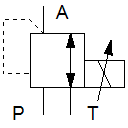3-way proportional pressure reducing valve

The valve maintains a constant output pressure despite fluctuating input pressure. If the pressure continues to rise, the hydraulic fluid is drained off at T. The valve is then working as a pressure relief valve.
The nominal pressure p_set is proportional to the control current. In the de-energized state of the solenoid, port P is closed and port A is connected with T.
The relation between current and nominal pressure p_set is modeled as a linear function. The current I_min_rel, at which the minimal nominal pressure p_min should be reached, must be specified relative to the maximum current.
In control mode the connection between P and A is initially fully open. As soon as the pressure at port A exceeds the nominal pressure, the spool moves and throttles the inlet flow from port P to A. If the pressure continues to rise, the connection between port P and A is closed and the connection between A and T starts to open.
The pressure regulation range p_reg is the pressure increment above the nominal pressure, at which the connection P-A is fully closed.
The connection P-A starts to close, when pA > p_set.
The connection P-A fully closed, when pA > p_set + p_reg.
The transition pressure range p_tr is the pressure increment above the pressure of the fully closed connection P-A, at which the connection A-T starts to open. The connection A-T is fully open after an additional increase by pressure regulation range p_reg.
The connection A-T starts to open, when pA > p_set + p_reg + p_tr.
The connection A-T fully open, when pA > p_set + p_reg + p_tr + p_reg = p_set + 2*p_reg + p_tr.
The hydraulic resistances relate to the fully open connections P-A and A-T.
Adjustable parameters
| Designation | Range | Default value |
|---|---|---|
| Min. Nominal pressure | 0 ... 400 bar | 0 |
| Max. Nominal pressure | 0 ... 400 bar | 110 |
| Min. Current (% I_max) | 0 ... 100 % | 10 |
| Designation | Range | Default value |
|---|---|---|
| Hydraulic resistance | 1e-6 ... 1000 bar.min2/l2 | 0.0625 |
| Pressure regulation range | 0.1 ... 400 bar | 20 |
| Transition pressure range | 0 ... 400 bar | 4 |